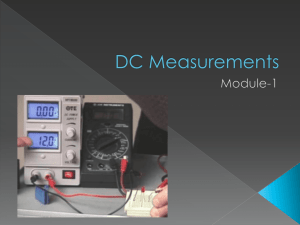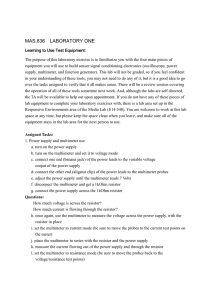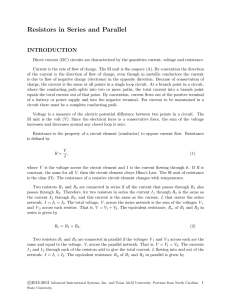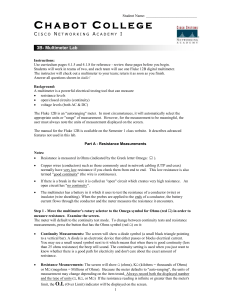Ohm's Law Lab - Rachel Brandenberg
advertisement
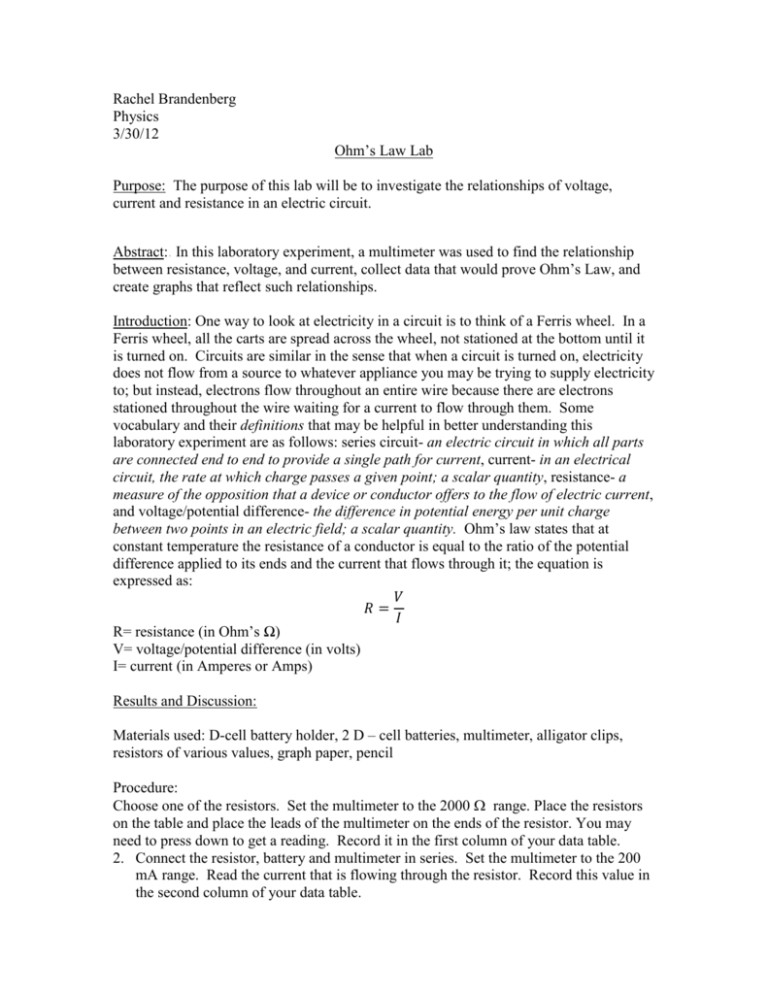
Rachel Brandenberg Physics 3/30/12 Ohm’s Law Lab Purpose: The purpose of this lab will be to investigate the relationships of voltage, current and resistance in an electric circuit. Abstract:. In this laboratory experiment, a multimeter was used to find the relationship between resistance, voltage, and current, collect data that would prove Ohm’s Law, and create graphs that reflect such relationships. Introduction: One way to look at electricity in a circuit is to think of a Ferris wheel. In a Ferris wheel, all the carts are spread across the wheel, not stationed at the bottom until it is turned on. Circuits are similar in the sense that when a circuit is turned on, electricity does not flow from a source to whatever appliance you may be trying to supply electricity to; but instead, electrons flow throughout an entire wire because there are electrons stationed throughout the wire waiting for a current to flow through them. Some vocabulary and their definitions that may be helpful in better understanding this laboratory experiment are as follows: series circuit- an electric circuit in which all parts are connected end to end to provide a single path for current, current- in an electrical circuit, the rate at which charge passes a given point; a scalar quantity, resistance- a measure of the opposition that a device or conductor offers to the flow of electric current, and voltage/potential difference- the difference in potential energy per unit charge between two points in an electric field; a scalar quantity. Ohm’s law states that at constant temperature the resistance of a conductor is equal to the ratio of the potential difference applied to its ends and the current that flows through it; the equation is expressed as: 𝑉 𝑅= 𝐼 R= resistance (in Ohm’s Ω) V= voltage/potential difference (in volts) I= current (in Amperes or Amps) Results and Discussion: Materials used: D-cell battery holder, 2 D – cell batteries, multimeter, alligator clips, resistors of various values, graph paper, pencil Procedure: Choose one of the resistors. Set the multimeter to the 2000 range. Place the resistors on the table and place the leads of the multimeter on the ends of the resistor. You may need to press down to get a reading. Record it in the first column of your data table. 2. Connect the resistor, battery and multimeter in series. Set the multimeter to the 200 mA range. Read the current that is flowing through the resistor. Record this value in the second column of your data table. 3. Disconnect the multimeter and connect it in parallel with the resistor and the battery. Change the multimeter setting to the 2 V DC scale and measure the voltage across the resistor. Record this value in the third column in your data table. 4. Remove the resistor and choose another. Repeat steps 1 - 3.0 5. Continue this process until you have the resistance, current and voltage of each resistor recorded in your data table. Data & Calculations: Bag 4. Resistance () Current (amp) 546 ohms .0054 663 ohms .0045 67 ohms .0416 457 ohms .0064 1/R .0018 .0015 .0149 .0022 Voltage (volts) 3.21 volts 3.21 volts 3.16 volts 3.20 volts Voltage/Resistance .0059 .0048 .0472 .0070 1. Construct a graph of Current (vertical axis) vs. Resistance. What type of relationship do you observe? -Here we see an inverse relationship/curve. 2. Construct a graph of Current (vertical axis) vs. 1/Resistance. Draw a best fit line by hand. Find the slope of the line. 𝑚= 𝑚= . 026 − .020 . 009 − .007 𝑦2− 𝑦1 𝑥2 − 𝑥1 𝑚(𝑠𝑙𝑜𝑝𝑒) = 3 3. What can you conclude about the slope of the line? (This question does not need to be answered directly in your lab. It is intended to help you make your conclusions.) 4. Ohm’s Law states that current is given by the ratio of voltage/resistance. Doesyour data concur with this? (This question does not need to be answered directly in your lab. It is intended to help you make your conclusions.) Conclusions: Resistance is not affected by voltage, as it is the initial source provided to the entire circuit; and voltage does not change throughout the circuit, there is only change seen in the current due to resistance. Ohm’s Law have been confirmed in this laboratory experiment because of the relationship seen between current, voltage, and resistance with the information collected; my data supported the fact that as resistance increases, current decreases.








